

Here's what was in the papers the day we arrived. People were dying all over Hawai'i, and most of them in Kaua'i. Before I left The Word warned me not to take a helicopter tour because he said they crashed "all the time". Maybe he was right. The Archivist was unfazed though. Nothing was going to keep her from her helicopter tour! I suggested we should book the tour with the company that had the crash. Hey, what were the odds that TWO 'copters from the same company would go down in the same month?
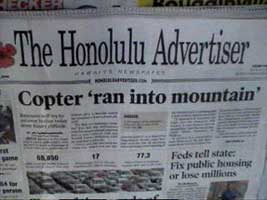 | 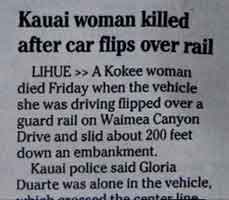 | 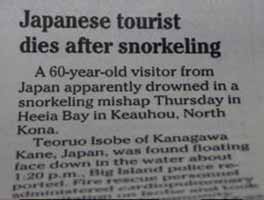 |
This National Wildlife Refuge was established to protect seabirds. This is a guaranteed stop on all geriatric bus tours of Kaua'i. The picturesque lighthouse was built in 1913 and is 52 feet tall. A 14-foot contemporary model has rendered it obsolete. I wouldn't really call it a lighthouse though. It looked more like a lamp post.
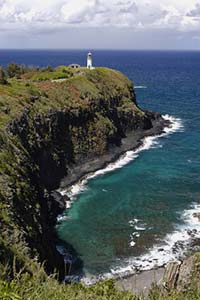 Kilauea Point |  Original lighthouse | 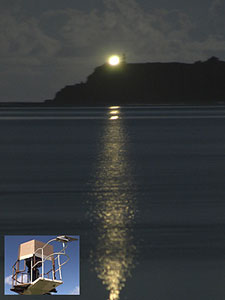 Kilauea point at night (inset = modern "lighthouse") |  Bird sign |
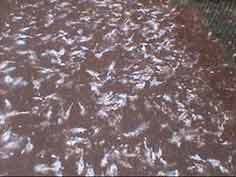 Sign of birds | 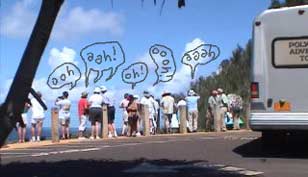 Flocking to see the birds | 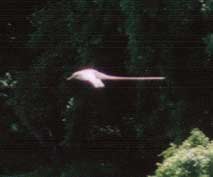 Tropicbird |
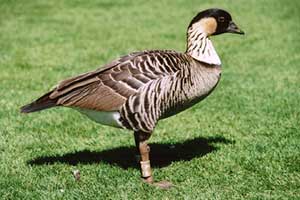 Nene | 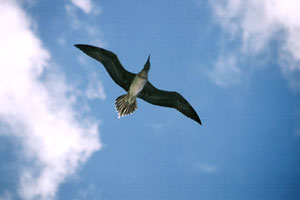 Wedge-tailed Shearwater | 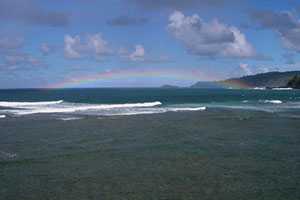 Kilauea Point and rainbow |
A large part of the Hanalei Valley is a National Wildlife Refuge. Taro farming in the valley provides wetland habitat for many water birds, including a number of endangered native Hawai'ian species. Only 5% of Hawai'i's original wetlands still exist today. Taro has been grown in the valley since before contact with Westerners. These days taro is hardly a cash crop, but government subsidies help preserve the tradition and avian habitat. Two-thirds of Hawai'i's commercial taro crop is grown here. From the valley overlook, the main road heads steeply downhill and over a one-lane bridge (bottom center below), which is credited with stopping the Westward spread of any large-scale development. A little further down the road is Hanalei Bay, considered to have some of the best beaches in Kaua'i.

Hanalei Valley
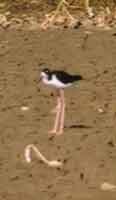 Hawai'ian Black- Necked Stilt | 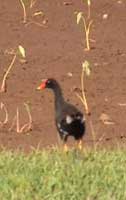 Hawai'ian Gallinule |  Feeding the taro | 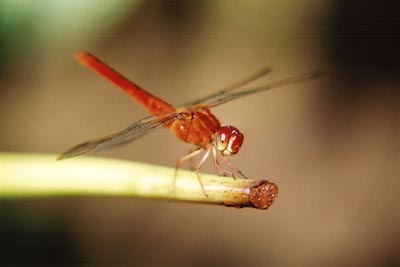 |
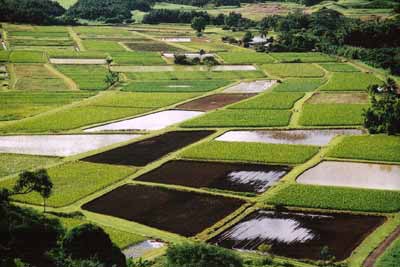 |
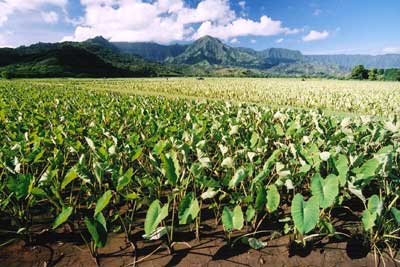 Taro |

Looking West across Hanalei Bay from Hanalei Beach Park (Black Pot)
Queen's Bath is located just East of Hanalei Bay. Large tidal pools along the shore are good for swimming when the ocean is not too rough. Occasionally someone swimming here is swept out to sea by a big wave. Many of the beaches we went to on Kaua'i had similar home-made memorials and/or warnings along the access paths. The Humuhumunukunukuapua'a below is Hawai'i's unofficial state fish.
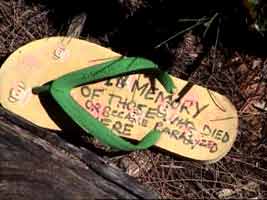 | 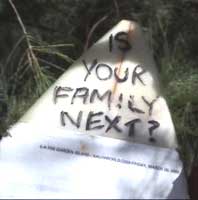 | 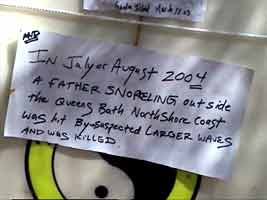 |
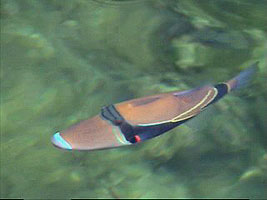 The Humuhumunukunukuapua'a | 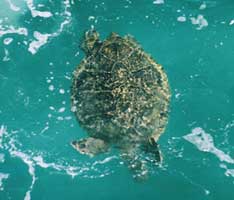 Turtle |  Fishy |
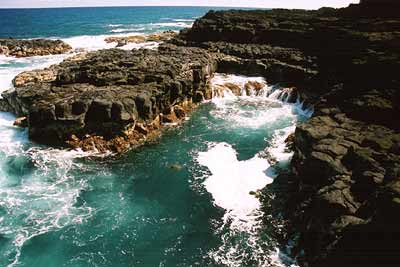 Shore at Queen's Bath, turtle at center | 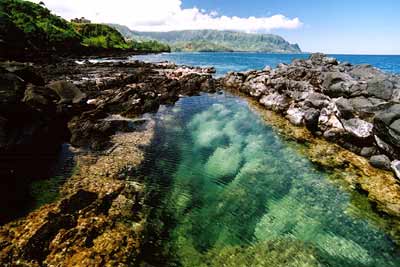 One of the pools |
The view overlooking this garden (first photo below) seems to show up in every book on Kaua'i. The alua plants are an endangered species. Supposedly there are only thirty or so of them growing on the cliffs behind the garden.
 Limahuli Garden | 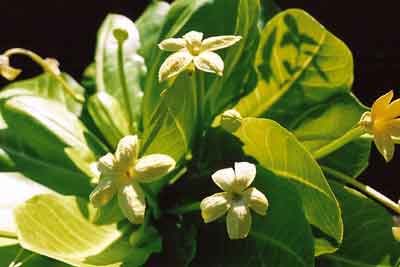 Alua |
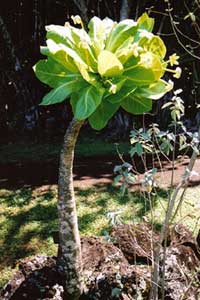 Alua | 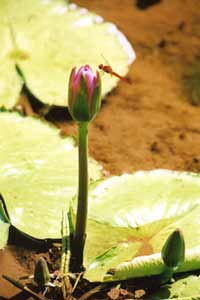 | 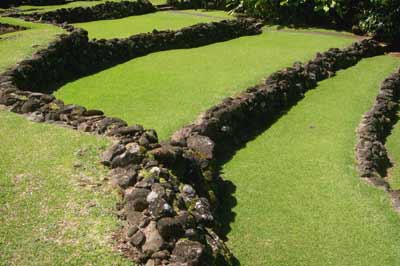 |
The Kalalau Trail is an 11-mile trail along Kaua'i's rugged Na Pali Coast, starting from Ke'e beach and ending at Kalalau Valley. In Hawai'ian, Na Pali means "the cliffs". The route is more or less the same as one used by native Hawai'ians who inhabited the valleys along the coast for hundreds of years. Some were still living traditionally in Kalalau Valley as late as 1919. Now they have been replaced by a sizeable hippie population, though probably nothing like the glory days in the 1960's before the area was declared Na Pali Coast State Park. Park rangers ran a cleanup operation the day before we arrived, hauling out two tons of garbage and chasing some of the squatters off.Too bad we missed all the action. The guide books advised against parking at Ke'e Beach because of frequent break-ins, but we didn't want to hike an extra mile so we did it anyway. It turned out to be a good decision because we didn't get robbed. We left before dawn and it took us the better part of the day to reach Kalalau. The scenery was fantastic but by the six-mile mark I was already starting to think it wasn't much fun anymore. The constant ascents and descents without any net gain in elevation, and the weaving in and out of valleys made it feel like we weren't making any progress. The conditions on the first leg of the trip were pretty miserable because of all the rain showers and mud. Away from the cliff edges there was little air movement and it got very steamy. Conditions did improve as the climate became increasingly arid along the trail. Kalalau Beach was almost desert-like. While hiking the trail we passed people sporting varying degrees of nudity (sorry, no pics). One woman was totally naked, one wore a top but no bottoms or underwear, and a more conservative one was just topless. Most were barefoot or in flip-flops, making me feel like a wimp in my clunky hiking boots. After finally reaching Kalalau Valley it really did feel like paradise. We had been keeping pace with a group of hippie types along the trail and we had passed one another a few times. They had barely acknowledged us to that point, but as we passed them at the trail's end they were smoking some pakalolo and were all smiles. "Great journey," one commented. Yeah dude, great trip. We spent the next day relaxing at Kalalau Beach. We could have done some day hikes but weren't feeling very ambitious, and the next day we had to hike all the way back out again. The pictures from both parts of the trip are mixed together below.
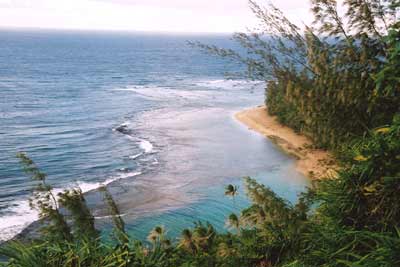 Ke'e beach - the trailhead |
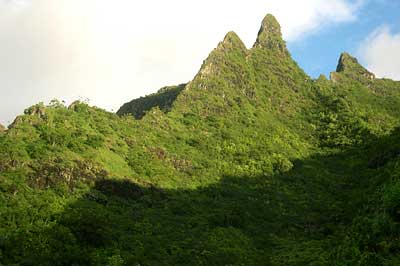 Cliffs by Ke'e |
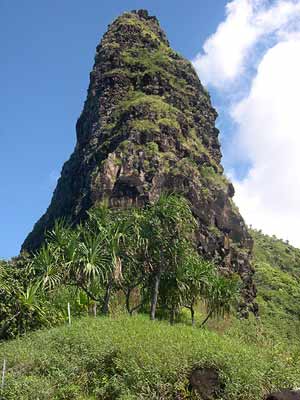 | 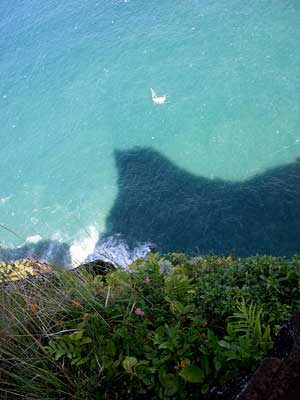 Looking down from trail |  Looking toward Ke'e |
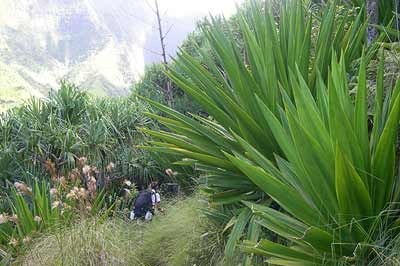 Welcome to the jungle | 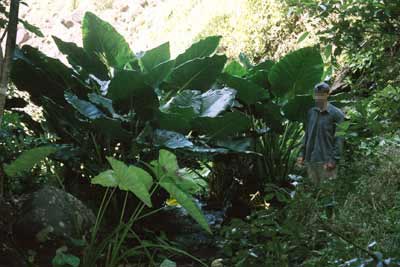 |
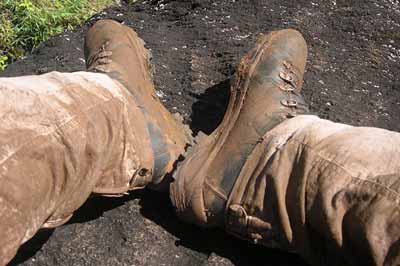 | 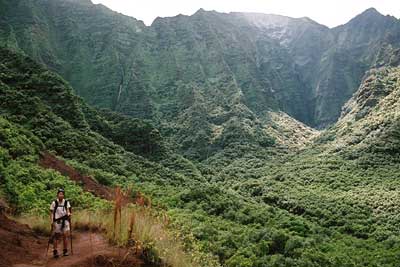 |
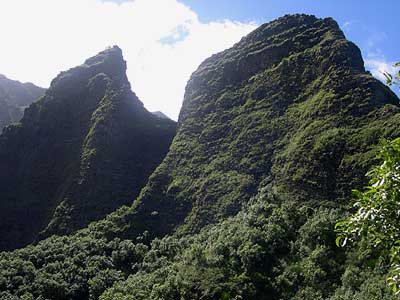 |  |
 Helluva high falls | 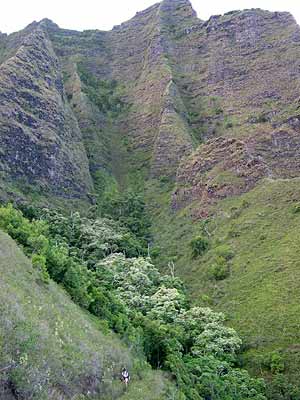 Tiny Archivist | 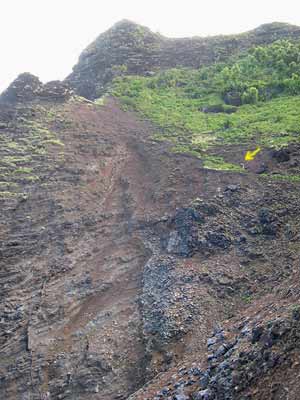 Puny Archivist |
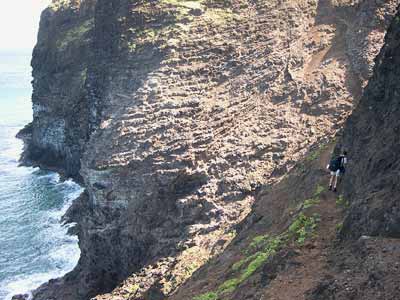 Edging around corner by upper left arrow in picture at right | 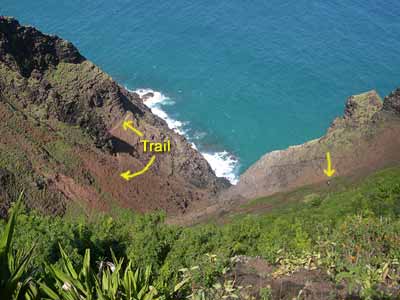 Arrows show trail and a hiker |
 Getting close to Kalalau | 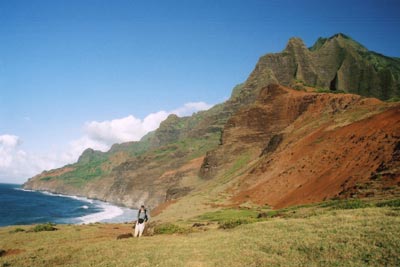 "Great journey!" Looking back from edge of Kalalau, just a mile or so to go |
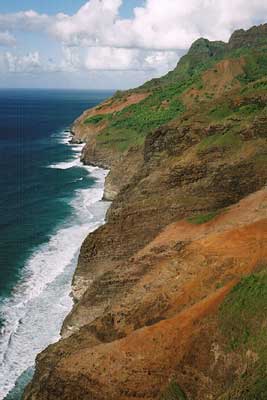 Near Kalalau, looking back at trail | 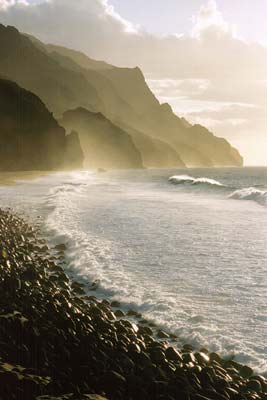 View when we finally reached Kalalau Beach | 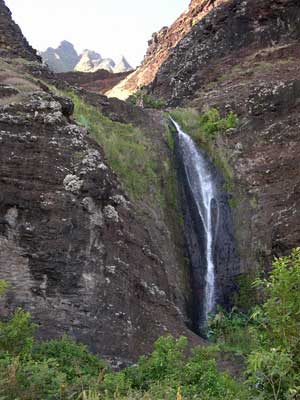 Camp water supply |
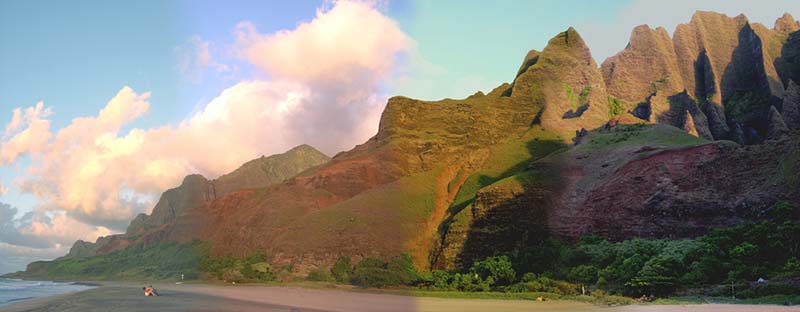
A badly pieced-together panorama of Kalalau Beach, with our tent bottom right
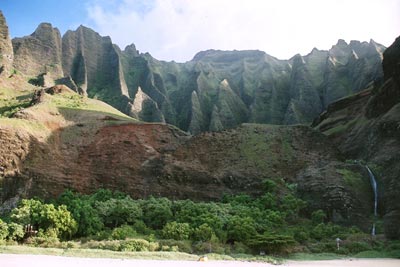 View from beach | 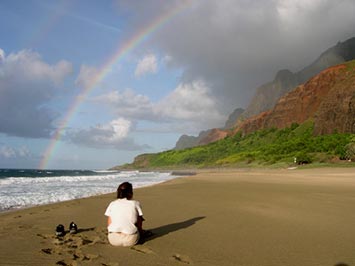 |
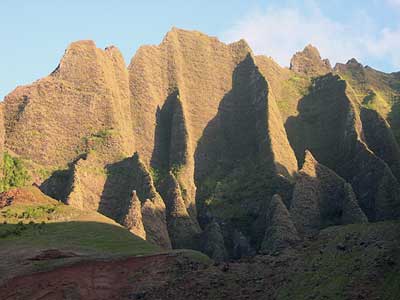 | 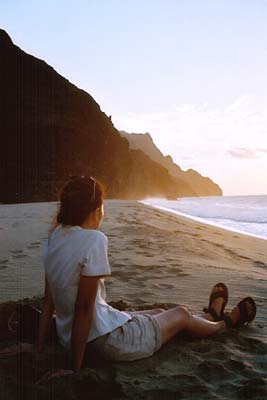 |
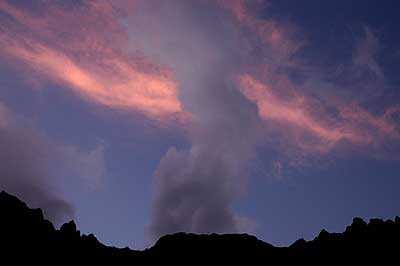
Interesting morning view
At our campsite on Kalalau Beach we got the feeling we were under surveillance. There was a constant parade of catamarans passing by on the water and helicopters flying overhead. I thought of mooning one of the boats but realized there was no point because half the people on the beach were already naked.
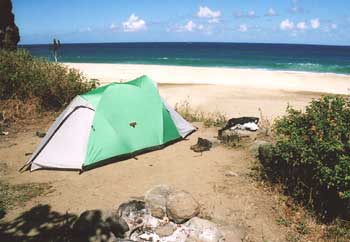 | 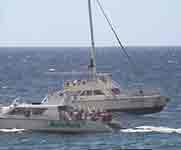 |  | 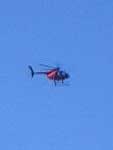 |  |
At the Western end of Kalalau Beach there were some sea caves. In the summer when the surf is low some people camp in them. The rough seas in winter cut down on visitors to the beach because many prefer to travel by kayak and raft. The beach looked really crowded in some summer photos I'd seen. It was pretty well winter season when we were there, and mid-week too, so there weren't many people there at all.
 | 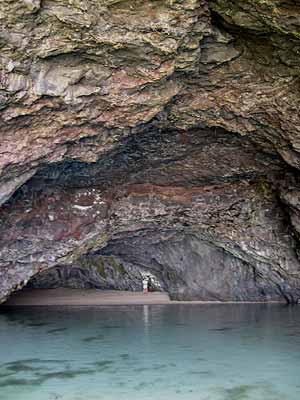 | 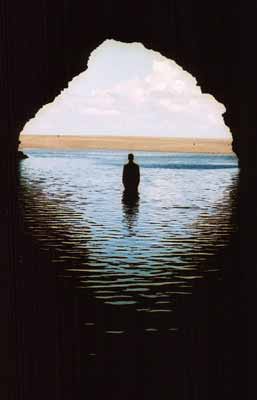 |
There were a lot more goats around Kalalau than what we saw in other areas of the island, probably because nobody could be bothered to hike all the way in to hunt them. Like the goats, Cane Toads are an introduced species. The glands on the sides of their heads secrete all kinds of nasty toxins if they are squeezed. The Cane Toad was probably introduced for the same reason it was in Australia -- as a biocontrol for beetles destroying sugar cane crops. Unfortunately the toads were nocturnal, while the beetles were diurnal, and the beetles were rarely on the ground where the toads could reach them. In other words, they were useless. These guys will eat just about anything, including small mammals, birds, and even pet food.
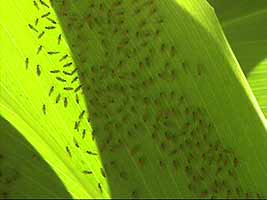 Flies on a leaf | 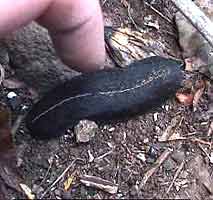 Aww, can we keep him mom? | 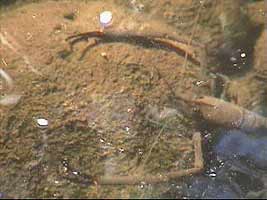 Long-armed crayfish | 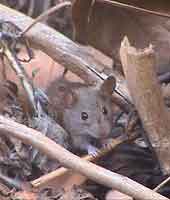 Mousie |
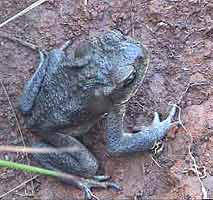 Cane Toad? | 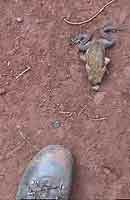 | 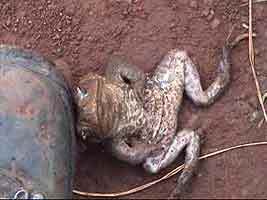 Dead Cane Toad |  Goat |
 Seal on Kalalau Beach |  Another goat | 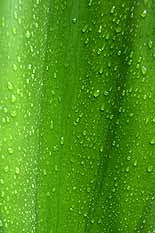 Leaf | 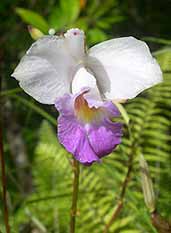 Orchid |
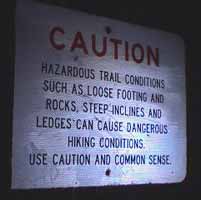 Start of trail | 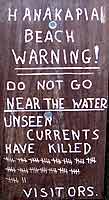 82 floaters | 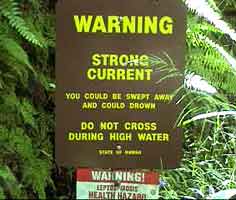 River crossing |  Helicopter landing site | 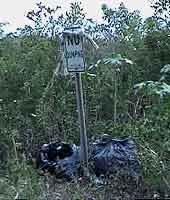 No dumping |
| "This is sacred land. Give it your utmost care, respect [it] and leave knowing you have preserved it for future generations." | 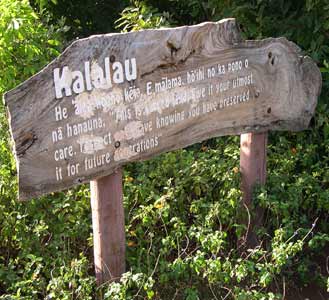 Before descent into Kalalau valley | 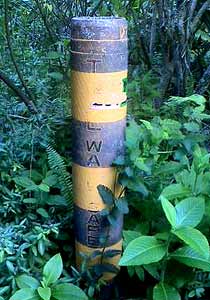 Tsunami safe zone marker |
| Visual Stimulation Menu | Main | Kauai Part 2>>> |